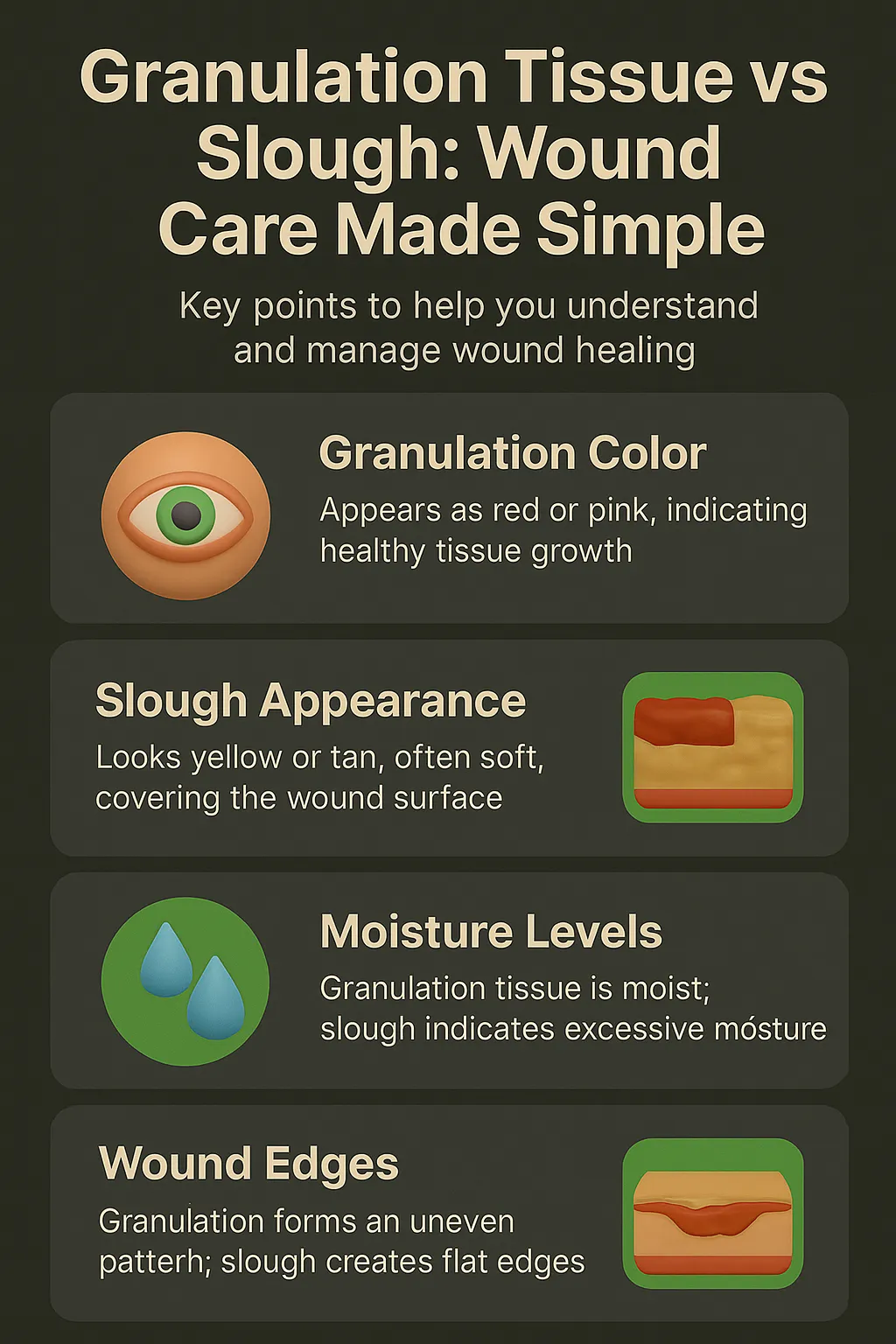In wound care, one of the fastest ways to interrupt healing is to confuse slough for granulation tissue. Granulation tissue is a positive sign that the wound is moving toward recovery, while slough can hide infection risks and slow healing progress. This guide will walk you through practical techniques for telling them apart, spotting subtle indicators that aren’t always found in textbooks, and applying real-world strategies for managing a granulation tissue slough wound that lead to better patient outcomes.
Top Takeaways
- Granulation vs. Slough: Granulation is healthy red or pink; slough is yellow, tan, or white.
- Act Early: Remove or treat slough promptly to keep healing on track.
- Look Closely: Changes in color or texture can signal a shift in wound condition.
- Choose Smart Care: Select wound dressings suited to the wound’s healing needs.
- Seek Expertise: Routine check-ins with a wound care professional boost outcomes.
Recognizing Granulation Tissue and Slough
Correct identification is essential for timely and effective treatment.
- Granulation tissue appears moist, red or pink, and has a grainy surface due to new capillary formation—indicating active healing.
- Slough is moist, yellow, tan, or white with a stringy or sticky texture. Made up of dead cells and debris, it can stall healing and often requires removal.
Successful wound care involves:
- Frequent assessment of the wound bed
- Monitoring changes in color, moisture, and texture
- Adjusting care plans immediately when tissue changes are observed
“In years of wound care, I’ve learned that a slight fade from healthy red granulation to pale yellow slough can shift the entire healing process.”
Case Study & Real-World Examples: Lessons in Practice
Case Study – Preventing Healing Delays in a Pressure Ulcer
- Patient in long-term care with healthy granulation tissue
- Small yellow-tan patch appeared at wound edge
- Identified as early slough from clinical experience
- Interventions:
- Targeted cleansing
- Dressing change for better moisture control
- Care staff trained to watch for subtle tissue changes
Real-World Observation – Color as an Early Warning
- Granulation tissue = bright pink
- Early slough = dull, opaque yellow
- Transition can happen within 24–48 hours
- Early action keeps healing on track
Research Support
- Journal of Wound Care (2021): Early removal of slough reduced chronic wound healing time by over 30%, confirming what I’ve observed in practice.
Supporting Statistics & Field Insights
- ~60,000 deaths annually in the U.S. are linked to pressure injuries – NPIAP: Pressure Injury Statistics
- 15% of Medicare patients have chronic nonhealing wounds, costing $28–$31B annually – NIH: Chronic Wound Management Research
Field Perspective: These figures represent real patients I’ve cared for. Early recognition and wound care management of slough can shorten healing time, prevent complications, and improve quality of life.
Final Thought & Opinion
- Key Point: Healing outcomes depend heavily on recognizing the difference between granulation tissue and slough.
- Impact: Delay in action can lead to higher treatment costs, longer recovery, and increased risk of infection.
- First-Hand Insight: Even the smallest visual change can be the biggest warning.
- Conclusion: The best results come from blending proven wound care methods with trained observation and swift action.
Next Steps
- Inspect wounds daily for any changes in color, texture, or moisture
- Record findings with photos or notes
- Address slough promptly to prevent healing stalls
- Select dressings that meet the wound’s needs for moisture and protection
- Schedule regular check-ins with a wound care specialist
Train caregivers to identify and respond to slough early
Frequently Asked Questions
What is the main difference between granulation tissue and slough?
Granulation tissue is healthy, red or pink, and indicates active healing. Slough is yellow, tan, or white and contains dead cells and debris that can slow recovery.
Why is it important to tell granulation tissue from slough?
Correct identification ensures timely intervention, prevents stalled healing, reduces infection risks, and helps maintain optimal recovery speed.
Can slough turn into granulation tissue?
No. Slough must first be removed or managed to allow the wound bed to return to a healthy state where granulation tissue can grow.
What’s the best way to manage slough in a wound?
Treatment may involve gentle wound cleansing, debridement by a healthcare professional, and dressings that promote moisture balance for healing.
How often should wounds be checked for granulation or slough?
Daily inspection is ideal, especially for high-risk patients. Early detection of slough or changes in granulation tissue leads to faster, more effective care.
When discussing granulation tissue vs slough: wound care made simple, it’s important to remember that a clean and controlled environment can make a significant difference in the healing process. Airborne dust, bacteria, and allergens can contribute to wound complications, making high-quality filtration and airflow management a valuable part of preventative care. Products like the 13.25x13.25x2 MERV 8 Air Filters help maintain cleaner indoor air, while services such as the Air Duct Sealing Company reduce contaminants entering through leaks in your HVAC system. Additional filtration options, including the 18x20x4 Pleated Furnace Filters, the 12x12x1 MERV 8 Pleated HVAC AC Furnace Air Filters 5-Pack, and the 18x20x4 Air Filter on eBay, further improve air quality. Combining this environmental control with the ability to identify and treat wound tissue types effectively can support faster healing and better patient outcomes.







